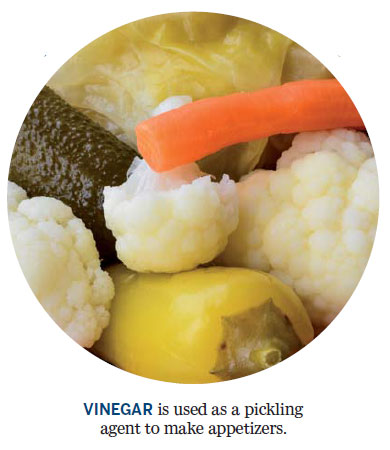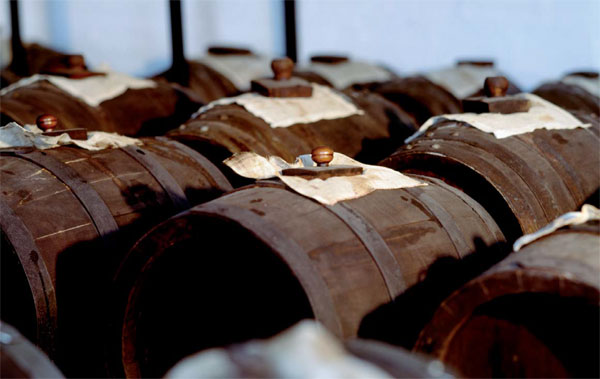A love affair with vinegar
Editor's note: China is divided into as many culinary regions as there are different ethnic groups. Its geographical diversity and kaleidoscopic cultural profiles contribute to an unending banquet of flavors.
Nothing wakes the palate better than the eye-popping tartness of a well-aged vinegar. And no one is better-known for a love of the sour vintage than the average Shanxi native.
Shanxi, a sprawling province west of Beijing, is a dusty mountainous region that is mostly parched and dry. Whatever water sources it has are heavily laced with minerals, resulting in very hard water high in alkalinity.
Its geography is far from lush, and the loess plateau watered by the Yellow River suits the cultivation of grassy vegetation. It grows mainly cereals like wheat, buckwheat, sorghum, naked oats, millet and barley.
|
Barrels are lined up in a vinegar factory in Shanxi province. Thanks to its geographic merits and its people's well-preserved skills, the province boasts of producing China's best vinegar. Photos Provided to China Daily |
So it stands to reason that Shanxi's main staples are noodles, dumplings and buns made from these rough grains.
A long time ago, the wise ancients here understood the advantages and weaknesses of making do. They considered these elements and started brewing vinegar to balance the body's PH levels from too much hard water and to aid digestion from eating grains that tax the guts. Most of all, they had the ready ingredients in those same cereals.
Shanxi is full of history, and it boasts the World Heritage site of Ping Yao, with its formidable rammed earth city wall and ancient temples dedicated to scholarship, and what might have been China's first bank. It is famous for a precarious miracle of construction - a cliff-edge temple that seems to defy gravity.
How old is Shanxi and its cultural heritage? Think in terms of millennia, like back to the time several hundred years before Christ. At that time, during China's Spring and Autumn Period (770-476 BC), it was already a thriving power base.
Vinegar production has always been a mainstay since the earliest days and throughout history's countless revolutions and political upheavals, that skill has been carefully treasured and preserved.
When you step off the train in Taiyuan, Shanxi you smell it immediately - that faint tickle to the nose that comes from the scent of open-front noodle stalls, souvenir shops selling bottles of vinegar from miniature samplers to huge vats, and even from the people full of local noodles doused in vinegar and garlic.
Here's an interesting aside as we delve into some linguistic roots: If you take apart the Chinese character for vinegar, you get radicals that tell the story - "wine", "twenty-one" and "days".
Indeed, before you get vinegar, you first get wine. But in Shanxi, the wine is only incidental in the fermentation process. It is the vinegar that is all important. However, it certainly takes more than 21 days to make a good vinegar. It may take half a lifetime.

While the sludge of cooked cereals may take just days to ferment, a good Shanxi vinegar needs a minimum aging of at least a year to develop its mellowness. Gourmets prefer the 30-year-old vintage, and the vinegar gets more rare and more expensive with every passing year.
While modern food fads now laud the many advantages of vinegar in cutting fats, culling cholesterol, clearing clogged arteries and the like, Shanxi natives have known the health benefits since time immemorial.
Aged vinegar so condensed that it has become molasses-like and is used in traditional Chinese medicine here.
Shanxi is the only place in China that values the sharpness of vinegar so much that it is the main signature of its culinary culture.
Apart from being an indispensable seasoning for noodles, there is yet another very practical reason for loving vinegar. Shanxi was and still is a major coal mining region, and miners believe that consuming vinegar will help clear the coal dust that they ingest.
Those who cook on coal-fired stoves believe that vinegar can help neutralize the fumes.
Shanxi's past kings and aristocracy enjoyed the best meat and fish, especially mutton and beef, but it is the cuisine of the common people that reflects the province's love of vinegar.
At any noodle stall in the province, large pots of vinegar and generous tubs of roasted chili oil are always part of the mise en place.
No matter what type of noodle or broth, the native Shanxi foodie will always add a dollop of chili and a generous drizzle of their favorite black vinegar. A favorite summer snack is cold noodles tossed in a spicy vinegar dressing.
Of course, vinegar is not just enjoyed in Shanxi.
Sour is one of the five tastes that balance a Chinese meal, and sweet and sour is a recognized favorite in many regional cuisines across the country.
In the south, the delicately deep-fried "squirrel" fish is doused in a sweet-sour sauce made with sour haw fruits. A Cantonese version uses tomatoes and maltose.
Also, in many regions in coastal China, pig trotters in a black vinegar broth is what every mother must eat after giving birth. The trotters are blanched before being slow-cooked in an earthen pot of vinegar, with plenty of ginger and sugar. It is believed that the vinegar will dissolve the calcium from the pork bones and make it easier for the postpartum mother to get instant nutrition.
In the north, a common household dish is sweet-and-sour cabbage stir-fry, which is simply torn up cabbage leaves quickly cooked in black vinegar and sugar. When the weather gets hot and humid, this is an easy vegetable to eat.
There is also an entire array of appetizers using vinegar as the pickling agent - turnips, radish, carrots, cabbages and even kelp.
A little bit goes a long way. Too much vinegar may sour the delicate balance. That's why an over-jealous wife is called a "vinegar pot" in Chinese.
paulined@chinadaily.com.cn
Sweet and Sour Glass Noodles
200 g mung bean or glass noodles
1 small carrot, shredded
2-3 spring onions, thinly cut on the diagonal
50 g crushed peanuts
2 tablespoons toasted sesame seeds
Dressing:
3 tablespoons quality black vinegar
2 tablespoons honey
1 tablespoon lemon or lime juice
2 tablespoons peanut or olive oil
Soak the noodles in cold water. Blanch in hot water for 30 seconds to soften and immediately place in bowl of ice water. This will cook the noodles, but retain some bite.
Cut the noodles into shorter lengths if you prefer, but do not chop them too short.
Toss the carrots, spring onions and glass noodles together.
Place dressing ingredients into a screw-top jar and shake well. You will get an emulsion.
Plate the salad, pour the dressing over it and garnish with crushed peanuts and sesame seeds.
|
A good Shanxi vinegar needs a minimum aging of at least a year to develop its mellowness. |
(China Daily Africa Weekly 03/03/2017 page19)


















